Birch
A birch is a thin-leaved deciduous hardwood tree of the genus Betula (/ˈbɛtjʊlə/),[2] in the family Betulaceae, which also includes alders, hazels, and hornbeams. It is closely related to the beech-oak family Fagaceae. The genus Betula contains 30 to 60 known taxa of which 11 are on the IUCN 2011 Red List of Threatened Species. They are a typically rather short-lived pioneer species widespread in the Northern Hemisphere, particularly in northern areas of temperate climates and in boreal climates.[3]
| Birch | |
|---|---|
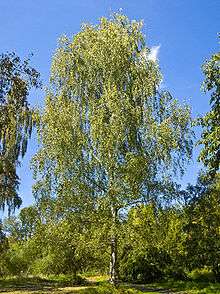 | |
| Silver birch | |
| Scientific classification | |
| Kingdom: | Plantae |
| Clade: | Tracheophytes |
| Clade: | Angiosperms |
| Clade: | Eudicots |
| Clade: | Rosids |
| Order: | Fagales |
| Family: | Betulaceae |
| Subfamily: | Betuloideae |
| Genus: | Betula L. |
| Subgenera | |
| |
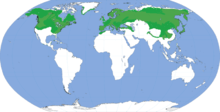 | |
| Range of Betula | |
| Synonyms[1] | |
| |
Description
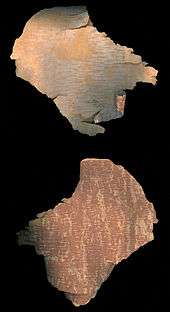
Birch species are generally small to medium-sized trees or shrubs, mostly of northern temperate and boreal climates. The simple leaves are alternate, singly or doubly serrate, feather-veined, petiolate and stipulate. They often appear in pairs, but these pairs are really borne on spur-like, two-leaved, lateral branchlets.[4] The fruit is a small samara, although the wings may be obscure in some species. They differ from the alders (Alnus, other genus in the family) in that the female catkins are not woody and disintegrate at maturity, falling apart to release the seeds, unlike the woody, cone-like female alder catkins.
The bark of all birches is characteristically marked with long, horizontal lenticels, and often separates into thin, papery plates, especially upon the paper birch. Distinctive colors give the common names gray, white, black, silver and yellow birch to different species.
The buds form early and are full grown by midsummer, all are lateral, no terminal bud is formed; the branch is prolonged by the upper lateral bud. The wood of all the species is close-grained with a satiny texture and capable of taking a fine polish; its fuel value is fair.
Flower and fruit
The flowers are monoecious, opening with or before the leaves and borne once fully grown these leaves are usually 3–6 millimetres (1⁄8–1⁄4 in) long on three-flowered clusters in the axils of the scales of drooping or erect catkins or aments. Staminate aments are pendulous, clustered or solitary in the axils of the last leaves of the branch of the year or near the ends of the short lateral branchlets of the year. They form in early autumn and remain rigid during the winter. The scales of the staminate aments when mature are broadly ovate, rounded, yellow or orange color below the middle, dark chestnut brown at apex. Each scale bears two bractlets and three sterile flowers, each flower consisting of a sessile, membranaceous, usually two-lobed, calyx. Each calyx bears four short filaments with one-celled anthers or strictly, two filaments divided into two branches, each bearing a half-anther. Anther cells open longitudinally. The pistillate aments are erect or pendulous, solitary; terminal on the two-leaved lateral spur-like branchlets of the year. The pistillate scales are oblong-ovate, three-lobed, pale yellow-green often tinged with red, becoming brown at maturity. These scales bear two or three fertile flowers, each flower consisting of a naked ovary. The ovary is compressed, two-celled, and crowned with two slender styles; the ovule is solitary. Each scale bears a single small, winged nut that is oval, with two persistent stigmas at the apex.
Taxonomy
Subdivision
Betula species are organised into five subgenera.
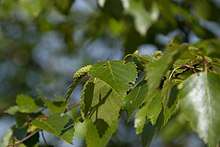
- Betula albosinensis – Chinese red birch (northern + central China)
- Betula alnoides – alder-leaf birch (China, Himalayas, northern Indochina)
- Betula ashburneri – (Bhutan, Tibet, Sichuan, Yunnan Provinces in China)
- Betula baschkirica – (eastern European Russia)
- Betula bomiensis – (Tibet)
- Betula browicziana – (Turkey and Georgia)
- Betula calcicola – (Sichuan + Yunnan Provinces in China)
- Betula celtiberica – (Spain)
- Betula chichibuensis – (Chichibu region of Japan)[5]
- Betula chinensis – Chinese dwarf birch (China, Korea)
- Betula coriaceifolia – (Uzbekistan)
- Betula corylifolia – (Honshu Island in Japan)
- Betula costata – (northeastern China, Korea, Primorye region of Russia)
- Betula cylindrostachya – (Himalayas, southern China, Myanmar)
- Betula dahurica – (eastern Siberia, Russian Far East, northeastern China, Mongolia, Korea, Japan)
- Betula delavayi – (Tibet, southern China)
- Betula ermanii – Erman's birch (eastern Siberia, Russian Far East, northeastern China, Korea, Japan)
- Betula falcata – (Tajikistan)
- Betula fargesii – (Chongqing + Hubei Provinces in China)
- Betula fruticosa – (eastern Siberia, Russian Far East, northeastern China, Mongolia, Korea, Japan)
- Betula globispica – (Honshu Island in Japan)
- Betula gmelinii – (Siberia, Mongolia, northeastern China, Korea, Hokkaido Island in Japan)
- Betula grossa – Japanese cherry birch (Japan)
- Betula gynoterminalis – (Yunnan Province in China)
- Betula honanensis – (Henan Province in China)
- Betula humilis or Betula kamtschatica – Kamchatka birch platyphylla (northern + central Europe, Siberia, Kazakhstan, Xinjiang, Mongolia, Korea)
- Betula insignis – (southern China)
- Betula karagandensis – (Kazakhstan)
- Betula klokovii – (Ukraine)
- Betula kotulae – (Ukraine)
- Betula luminifera – (China)
- Betula maximowiczii – monarch birch (Japan, Kuril Islands)
- Betula medwediewii – Caucasian birch (Turkey, Iran, Caucasus)
- Betula megrelica – (Republic of Georgia)
- Betula microphylla – (Siberia, Mongolia, Xinjiang, Kazakhstan, Kyrgyzstan, Uzbekistan)
- Betula nana – dwarf birch (northern + central Europe, Russia, Siberia, Greenland, Northwest Territories of Canada))
- Betula pendula – silver birch (widespread in Europe and northern Asia; Morocco; naturalized in New Zealand and scattered locations in US + Canada)
- Betula platyphylla – (Betula pendula var. platyphylla)—Siberian silver birch (Siberia, Russian Far East, Manchuria, Korea, Japan, Alaska, western Canada)
- Betula potamophila – (Tajikistan)
- Betula potaninii – (southern China)
- Betula psammophila – (Kazakhstan)
- Betula pubescens – downy birch, also known as white, European white or hairy birch (Europe, Siberia, Greenland, Newfoundland; naturalized in scattered locations in US)
- Betula raddeana – (Caucasus)
- Betula saksarensis – (Khakassiya region of Siberia)
- Betula saviczii – (Kazakhstan)
- Betula schmidtii – (northeastern China, Korea, Japan, Primorye region of Russia)
- Betula sunanensis – (Gansu Province of China)
- Betula szechuanica – (Betula pendula var. szechuanica)—Sichuan birch (Tibet, southern China)
- Betula tianshanica – (Kazakhstan, Kyrgyzstan, Tajikistan, Uzbekistan, Xinjiang, Mongolia)
- Betula utilis – Himalayan birch (Afghanistan, Central Asia, China, China, Tibet, Himalayas)
- Betula wuyiensis – (Fujian Province of China)
- Betula zinserlingii – (Kyrgyzstan)
Note: many American texts have B. pendula and B. pubescens confused, though they are distinct species with different chromosome numbers.
- Birches native to North America include
- Betula alleghaniensis – yellow birch (B. lutea) (eastern Canada, Great Lakes, upper eastern US, Appalachians)
- Betula caerulea – blue birch (northeast of North America)
- Betula cordifolia – mountain paper birch (eastern Canada, Great Lakes, New England US)
- Betula glandulosa – American dwarf birch (Siberia, Mongolia, Russian Far East, Alaska, Canada, Greenland, mountains of western US and New England, Adirondacks)
- Betula lenta – sweet birch, cherry birch, or black birch (Quebec, Ontario, eastern US)
- Betula michauxii – Newfoundland dwarf birch (Newfoundland, Labrador, Quebec, Nova Scotia)
- Betula minor – dwarf white birch (eastern Canada, mountains of northern New England and Adirondacks)
- Betula murrayana – Murray's birch (Great Lakes endemic)
- Betula nana – dwarf birch or bog birch (also in northern Europe and Asia)
- Betula neoalaskana – Alaska paper birch also known as Alaska birch or Resin birch (Alaska and northern Canada)
- Betula nigra – river birch or black birch (eastern US)
- Betula occidentalis – water birch or red birch (B. fontinalis) (Alaska, Yukon, Northwest Territories, western Canada, western US)
- Betula papyrifera – paper birch, canoe birch or American white birch (Alaska, most of Canada, northern US)
- Betula populifolia – gray birch (eastern Canada, northeastern US)
- Betula pumila – swamp birch (Alaska, Canada, northern US)
- Betula uber – Virginia round-leaf birch (southwestern Virginia)
Etymology
The common name birch comes from Old English birce, bierce, from Proto-Germanic *berk-jōn (cf. German Birke, West Frisian bjirk), an adjectival formation from *berkōn (cf. Dutch berk, Low German Bark, Danish birk, Norwegian bjørk), itself from the Proto-Indo-European root *bʰerHǵ- ~ bʰrHǵ-, which also gave Lithuanian béržas, Latvian Bērzs, Russian beréza, Ukrainian beréza, Albanian bredh ‘fir’, Ossetian bærz(æ), Sanskrit bhurja, Polish brzoza, Latin fraxinus ‘ash (tree)’. This root is presumably derived from *bʰreh₁ǵ- ‘to shine’, in reference to the birch's white bark. The Proto-Germanic rune berkanan is named after the birch.
The generic name betula is from Latin, which is a diminutive borrowed from Gaulish betua (cf. Old Irish bethe, Welsh bedw).
Ecology
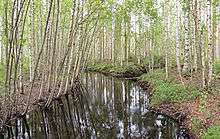
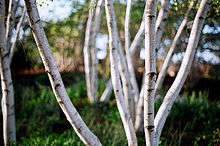
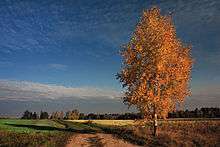
Birches often form even-aged stands on light, well-drained, particularly acidic soils. They are regarded as pioneer species, rapidly colonizing open ground especially in secondary successional sequences following a disturbance or fire. Birches are early tree species to become established in primary successions, and can become a threat to heathland if the seedlings and saplings are not suppressed by grazing or periodic burning. Birches are generally lowland species, but some species, such as Betula nana, have a montane distribution. In the British Isles, there is some difference between the environments of Betula pendula and Betula pubescens, and some hybridization, though both are "opportunists in steady-state woodland systems". Mycorrhizal fungi, including sheathing (ecto)mycorrhizas, are found in some cases to be beneficial to tree growth.[6]
A large number of lepidopteran insects feed on birch foliage.
Uses
Because of the hardness of birch, it is easier to shape it with power tools; it is quite difficult to work it with hand tools.[7]
- Birch wood is fine-grained and pale in colour, often with an attractive satin-like sheen. Ripple figuring may occur, increasing the value of the timber for veneer and furniture-making. The highly decorative Masur (or Karelian) birch, from Betula verrucosa var. carelica, has ripple textures combined with attractive dark streaks and lines.
- Birch plywood is made from laminations of birch veneer. It is light but strong, and has many other good properties. It is among the strongest and dimensionally most stable plywoods, although it is unsuitable for exterior use. Birch plywood is used to make longboards (skateboard), giving it a strong yet flexible ride. It is also used (often in very thin grades with many laminations) for making model aircraft.
- Extracts of birch are used for flavoring or leather oil, and in cosmetics such as soap or shampoo. In the past, commercial oil of wintergreen (methyl salicylate) was made from the sweet birch (Betula lenta).
- Birch-tar or Russian oil extracted from birch bark is thermoplastic and waterproof; it was used as a glue on, for example, arrows, and also for medicinal purposes.[8]
- Fragrant twigs of wintergreen group birches are used in saunas to relax the muscles.
- Birch is also associated with the feast of Pentecost in Central and Eastern Europe and Siberia, where its branches are used as decoration for churches and homes on this day.
- Birch leaves are used to make a diuretic tea and extracts for dyes and cosmetics.
- Ground birch bark, fermented in sea water, is used for seasoning the woolen, hemp or linen sails and hemp rope of traditional Norwegian boats.
- Birch twigs bound in a bundle, also called birch, were used for birching, a form of corporal punishment.
- Many Native Americans in the United States and Indigenous peoples in Canada prize the birch for its bark, which because of its light weight, flexibility, and the ease with which it can be stripped from fallen trees, is often used for the construction of strong, waterproof but lightweight canoes, bowls, and wigwams.
- The Hughes H-4 Hercules was made mostly of birch wood, despite its better-known moniker, "The Spruce Goose".
- Birch plywood was specified by the BBC as the only wood that can be used in making the cabinets of the long-lived LS3/5A loudspeaker.[9]
- Birch is used as firewood because of its high calorific value per unit weight and unit volume. It burns well, without popping, even when frozen and freshly hewn. The bark will burn very well even when wet because of the oils it contains. With care, it can be split into very thin sheets that will ignite from even the smallest of sparks.
- Birch sap is a traditional drink in Northern Europe, Siberia, and Northern China. The sap is also bottled and sold commercially. Birch sap can be used to make birch syrup, which is used like maple syrup for pancakes and waffles. Birch wood can be used to smoke foods.
- Birch seeds are used as leaf litter in miniature terrain models.[10]
- Birch oil is used in the manufacture of Russia leather, a water-resistant leather.
Cultivation
White-barked birches in particular are cultivated as ornamental trees, largely for their appearance in winter. The Himalayan birch, Betula utilis, especially the variety or subspecies jacquemontii, is among the most widely planted for this purpose. It has been cultivated since the 1870s, and many cultivars are available, including 'Doorenbos', 'Grayswood Ghost' and 'Silver Shadow'; 'Knightshayes' has a slightly weeping habit. Other species with ornamental white bark include Betula ermanii, Betula papyrifera, Betula pendula and Betula raddeana.[11]
Medical
- Birch bark is high in betulin and betulinic acid, phytochemicals which have potential as pharmaceuticals, and other chemicals which show promise as industrial lubricants.
- Birch buds are used in folk medicine.[12]
- Birch bark can be soaked until moist in water, and then formed into a cast for a broken arm.[13]
- The inner bark of birch can be ingested safely.
- In northern latitudes, birch is considered to be the most important allergenic tree pollen, with an estimated 15–20% of hay fever sufferers sensitive to birch pollen grains. The major allergen is a protein called Bet v I.
- Birches have been in use in Russia for health and a healthy skin since ancient times.[14]
Paper
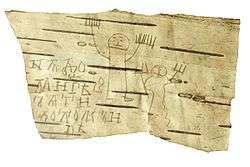
Wood pulp made from birch gives relatively long and slender fibres for a hardwood. The thin walls cause the fibre to collapse upon drying, giving a paper with low bulk and low opacity. The birch fibres are, however, easily fibrillated and give about 75% of the tensile strength of softwood.[15] The low opacity makes it suitable for making glassine.
In India, the birch (Sanskrit: भुर्ज, bhurja) holds great historical significance in the culture of North India, where the thin bark coming off in winter was extensively used as writing paper. Birch paper (Sanskrit: भुर्ज पत्र, bhurja patra) is exceptionally durable and was the material used for many ancient Indian texts.[16][17] The Roman period Vindolanda tablets also use birch as a material on which to write and birch bark was used widely in ancient Russia as note paper (beresta) and for decorative purposes and even making footwear.
Tonewood
Baltic birch is among the most sought-after wood in the manufacture of speaker cabinets. Birch has a natural resonance that peaks in the high and low frequencies, which are also the hardest for speakers to reproduce. This resonance compensates for the roll-off of low and high frequencies in the speakers, and evens the tone. Birch is known for having "natural EQ".
Drums are often made from birch. Prior to the 1970s, it was one of the most popular drum woods. Because of the need for greater volume and midrange clarity, drums were made almost entirely from maple until recently, when advances in live sound reinforcement and drum microphones have allowed the use of birch in high-volume situations. Birch drums have a natural boost in the high and low frequencies, which allows the drums to sound fuller.
Birch wood is sometimes used as a tonewood for semiacoustic and acoustic guitar bodies, and occasionally for solid-body guitar bodies. It is also a common material used in mallets for keyboard percussion.
Culture
Birches have spiritual importance in several religions, both modern and historical. In Celtic cultures, the birch symbolises growth, renewal, stability, initiation, and adaptability because it is highly adaptive and able to sustain harsh conditions with casual indifference. Proof of this adaptability is seen in its easy and eager ability to repopulate areas damaged by forest fires or clearings. Birches are also associated with the Tír na nÓg, the land of the dead and the Sidhe, in Gaelic folklore, and as such frequently appear in Scottish, Irish, and English folksongs and ballads in association with death, or fairies, or returning from the grave. The leaves of the silver birch tree are used in the festival of St George, held in Novosej and other villages in Albania.[18]
The birch is New Hampshire's state tree and the national tree of Finland and Russia. The birch is a very important element in Russian culture and represents the grace, strength, tenderness and natural beauty of Russian women as well as the closeness to nature of the Russians.[19] It's associated with marriage and love.[20] There are numerous folkloric Russian songs in which the birch tree occurs. The Ornäs birch is the national tree of Sweden. The Czech word for the month of March, Březen, is derived from the Czech word bříza meaning birch, as birch trees flower in March under local conditions. The silver birch tree is of special importance to the Swedish city of Umeå. In 1888, the Umeå city fire spread all over the city and nearly burnt it down to the ground, but some birches, supposedly, halted the spread of the fire. To protect the city against future fires, wide avenues were created, and these were lined with silver birch trees all over the city. Umeå later adopted the unofficial name of "City of the Birches (Björkarnas stad)". Also, the ice hockey team of Umeå is called Björklöven, translated to English "The Birch Leaves".
"Swinging" birch trees was a common game for American children in the nineteenth century. American poet Lucy Larcom's "Swinging on a Birch Tree" celebrates the game.[21] The poem inspired Robert Frost, who pays homage to the act of climbing birch trees in his more famous poem, "Birches".[22] Frost once told "it was almost sacrilegious climbing a birch tree till it bent, till it gave and swooped to the ground, but that's what boys did in those days".[23]
See also
- Birch bark
- Birch bark manuscript
- Birch beer
- Taxonomy of Betula
References
- "World Checklist of Selected Plant Families: Royal Botanic Gardens, Kew". apps.kew.org.
- Sunset Western Garden Book, 1995:606–607
- Ashburner, K. & McAllister, H.A. (2013). The genus Betula: a taxonomic revision of birches: 1-431. Royal Botanic Gardens, Kew.
- Keeler, Harriet L. (1900). Our Native Trees and How to Identify Them. New York: Charles Scribner's Sons. pp. 295–297.
- Kinver, Mark (30 September 2015). "UK team germinates critically endangered Japanese birch". BBC News. BBC. Retrieved 30 September 2015.
- Birches. (A Symposium, Royal Botanic Garden, Edinburgh 24–26 September 1982. Proceedings of the Royal Society of Edinburgh, 85B, 1–11, 1984.
- "Birch". Wood Magazine. Retrieved December 1, 2013.
- "Birch Tar – How to collect it". Archived from the original on February 27, 2008.
- Prakel, David (August 1979). "BBC's Home Service", Hi-Fi Answers, pp67–9 (Courtesy link)
- Joyce, Daniel. "Birch Seed Leaves". reapermini.com. Archived from the original on 2010-12-31. Retrieved 2010-04-09.
- Bartlett, Paul (2015). "White-barked birches". The Plantsman (New Series). 14 (3): 146–151.
- White Birch – American Cancer Society (cancer.org)
- William Arthur Clark (January 1, 1937). "History of Fracture Treatment Up to the Sixteenth Century". The Journal of Bone and Joint Surgery. Needham, MA, USA: The Journal of Bone and Joint Surgery, Inc. 19 (1): 61–62. Archived from the original on December 3, 2013. Retrieved December 2, 2013.
Another method cited was that of splints made of birch bark soaked in water until quite soft. They were then carefully fitted to the limb and tied with bark thongs. On drying, they became stiff and firm. There is no record of the use of extension, but, nevertheless, very few crippled and deformed Indians were to be seen.
- Russia--women--culture. Goscilo, Helena, 1945-, Holmgren, Beth, 1955-. Bloomington: Indiana University Press. 1996. p. 26. ISBN 058500093X. OCLC 42328430.CS1 maint: others (link)
- Nanko, Hiroki; Button, Alan; Hillman, Dave (2005). The World of Market Pulp. USA: WOMP, LLC. pp. 192–195. ISBN 0-615-13013-5.
- Sanjukta Gupta, "Lakṣmī Tantra: A Pāñcarātra Text", Brill Archive, 1972, ISBN 90-04-03419-6. Snippet:... the text recommends that the bark of the Himalayan birch tree (bhurja-patra) should be used for scribbling mantras ...
- Amalananda Ghosh, "An Encyclopaedia of Indian Archaeology", BRILL, 1990, ISBN 90-04-09264-1. Snippet:... Bhurja-patra, the inner bark on the birch tree grown in the Himalayan region, was a very common writing material ...
- "Traditional celebrations in Novosej". RASP. Retrieved August 28, 2013.
- "The Birch: Russia's Tree | News & Info". kurochkaclothing.com. Retrieved 2018-09-24.
- 1932-1996., Weiss, Peg (1995). Kandinsky and Old Russia : the artist as ethnographer and shaman. Kandinsky, Wassily, 1866-1944. New Haven: Yale University Press. p. 36. ISBN 0300056478. OCLC 30701876.CS1 maint: numeric names: authors list (link)
- Pfileger, Pat. "Our Young Folks: Swinging on a Birch-Tree, by Lucy Larcom & Winslow Homer (1867)". Merry Coz.
- Fagan, Deirdre J. (2007). Critical Companion to Robert Frost: A Literary Reference to His Life and Work. Infobase Publishing. p. 42. ISBN 978-1-4381-0854-4. Retrieved 10 November 2013.
- Parini, Jay (1999). Robert Frost: A Life. New York: Halt. p. 22. ISBN 0-8050-3181-2.
Sources
- Furlow, John J. (1997). "Betula". In Flora of North America Editorial Committee (ed.). Flora of North America North of Mexico (FNA). 3. New York and Oxford – via eFloras.org, Missouri Botanical Garden, St. Louis, MO & Harvard University Herbaria, Cambridge, MA.
- Li, Pei-chun; Skvortsov, Alexei K. "Betula". Flora of China. 4 – via eFloras.org, Missouri Botanical Garden, St. Louis, MO & Harvard University Herbaria, Cambridge, MA.
- Grimshaw, John (2009). New Trees, Recent introductions to cultivation. Kew Publishing, RBG Kew. pp. 163–174.
- Chisholm, Hugh, ed. (1911). . Encyclopædia Britannica. 3 (11th ed.). Cambridge University Press.
External links
| Wikimedia Commons has media related to Betula. |
- Tree Family Betulaceae Diagnostic photos of many species, Morton Arboretum specimens
- Eichhorn, Markus (July 2010). "The Birch Tree". Test Tube. Brady Haran for the University of Nottingham.